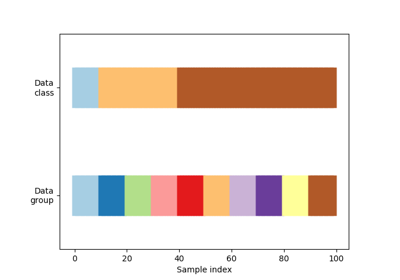sklearn.model_selection.GroupShuffleSplit¶
-
class
sklearn.model_selection.GroupShuffleSplit(n_splits=5, test_size='default', train_size=None, random_state=None)[source]¶ Shuffle-Group(s)-Out cross-validation iterator
Provides randomized train/test indices to split data according to a third-party provided group. This group information can be used to encode arbitrary domain specific stratifications of the samples as integers.
For instance the groups could be the year of collection of the samples and thus allow for cross-validation against time-based splits.
The difference between LeavePGroupsOut and GroupShuffleSplit is that the former generates splits using all subsets of size
punique groups, whereas GroupShuffleSplit generates a user-determined number of random test splits, each with a user-determined fraction of unique groups.For example, a less computationally intensive alternative to
LeavePGroupsOut(p=10)would beGroupShuffleSplit(test_size=10, n_splits=100).Note: The parameters
test_sizeandtrain_sizerefer to groups, and not to samples, as in ShuffleSplit.Parameters: - n_splits : int (default 5)
Number of re-shuffling & splitting iterations.
- test_size : float, int, None, optional
If float, should be between 0.0 and 1.0 and represent the proportion of the dataset to include in the test split. If int, represents the absolute number of test samples. If None, the value is set to the complement of the train size. By default, the value is set to 0.2. The default will change in version 0.21. It will remain 0.2 only if
train_sizeis unspecified, otherwise it will complement the specifiedtrain_size.- train_size : float, int, or None, default is None
If float, should be between 0.0 and 1.0 and represent the proportion of the groups to include in the train split. If int, represents the absolute number of train groups. If None, the value is automatically set to the complement of the test size.
- random_state : int, RandomState instance or None, optional (default=None)
If int, random_state is the seed used by the random number generator; If RandomState instance, random_state is the random number generator; If None, the random number generator is the RandomState instance used by np.random.
Methods
get_n_splits([X, y, groups])Returns the number of splitting iterations in the cross-validator split(X[, y, groups])Generate indices to split data into training and test set. -
__init__(n_splits=5, test_size='default', train_size=None, random_state=None)[source]¶ Initialize self. See help(type(self)) for accurate signature.
-
get_n_splits(X=None, y=None, groups=None)[source]¶ Returns the number of splitting iterations in the cross-validator
Parameters: - X : object
Always ignored, exists for compatibility.
- y : object
Always ignored, exists for compatibility.
- groups : object
Always ignored, exists for compatibility.
Returns: - n_splits : int
Returns the number of splitting iterations in the cross-validator.
-
split(X, y=None, groups=None)[source]¶ Generate indices to split data into training and test set.
Parameters: - X : array-like, shape (n_samples, n_features)
Training data, where n_samples is the number of samples and n_features is the number of features.
- y : array-like, shape (n_samples,), optional
The target variable for supervised learning problems.
- groups : array-like, with shape (n_samples,)
Group labels for the samples used while splitting the dataset into train/test set.
Yields: - train : ndarray
The training set indices for that split.
- test : ndarray
The testing set indices for that split.
Notes
Randomized CV splitters may return different results for each call of split. You can make the results identical by setting
random_stateto an integer.


